#sandhill milkweed
Explore tagged Tumblr posts
Text
*cracks knuckles* Alright everyone strap in.
Hi, I'm Ani, the appointed Milkweed Queen of several Discord group chats, and I'm gonna talk about some of my favorite types of milkweed because its Earth Day, I'm bored, and I had nothing else ready to post. Everyone ready?
I'm not going to give these a formal ranking, I'm just going to ramble about them.
We all know the important reasons to like milkweed--supporting Monarchs, feeding the pollinators, restoring native species to your local habitat and creating an environment for many creatures to live in, that's all fantastic obviously. With that established, this ranking system will have little to do with that. We're talking aesthetics, babey! And any fun facts I happen to toss in are, well, fun facts. If you learn about a new kind of milkweed from this, or want to chime in with your own favorites, by all means let me know!

Swamp milkweed (Asclepias incarnata)! If you've been following my blog for awhile, you likely know I've been on a Grand Quest to find, purchase, and/or grow swamp milkweed for a few years now. Honestly, though, who can blame me! Look at those vibrant pink flowers, contrasting with those bright green leaves! Love at first sight, I'm telling you. I've also heard that it smells like vanilla. Vanilla! It's also, reportedly, one of the few types of milkweed that excels in wet environments, and even though my environment isn't very wet, we stan a queen for that quality.

Whether you prefer to call it Sandhill Milkweed or Pinewoods Milkweed, Asclepias humistrata is a champion of sandy soils and also my heart. I hadn't looked too far into this species until late last year, when I was helping another friend look at different milkweeds, but how could I not look into this beautiful plant! With pink stems and veins as early as the seedling stage, pinkish-white flowers and a low-growing spread habit, I would be honored to grow such a specimen in my garden. Their inch-thick, foot-long tap roots help them to quickly spring back to life after a wildfire, providing important food and habitat for creatures returning to the area. How lovely!
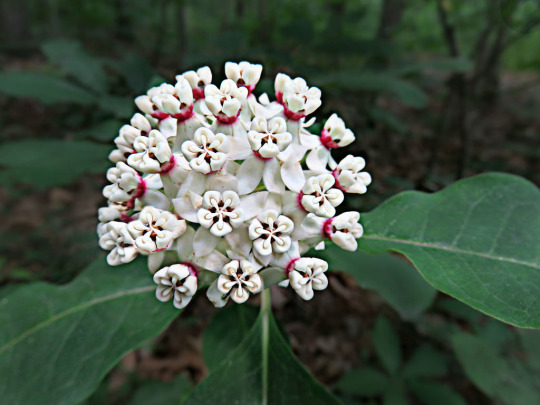
Redring milkweed (Asclepias variegata) is another species I hadn't looked too far into until this year, and honestly at great detriment to myself. I'll be honest! I may have ignored this queen at first because I'm not big on white flowers, but those red rings...! Ooh, I want this so bad. The leaves are also fairly big and a lovely dark green, which just makes the white and red pop out more!
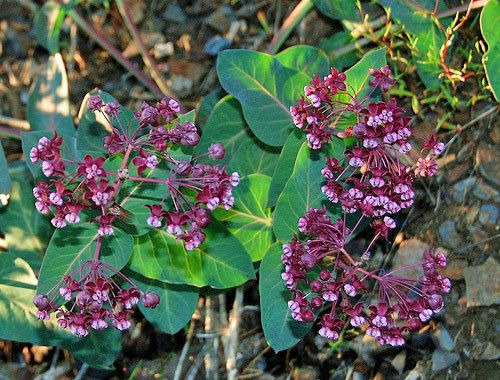
Heartleaf milkweed (Asclepias cordifolia) is honestly so iconic, I wish it was native to my region! If you live on the West coast... grow some for me please. How can you not love this specimen! Dusty green heart-shaped leaves directly attached to pink stems, these stunning deep reddish-purple flower clusters...! I continued following one of the most annoying people I'd ever witnessed on Instagram for two months just because I first saw this species in a tiktok of his.

Purple milkweed (Asclepias purparescens) is honestly just. A queen. What else is there to say? Look how purple she is! So purple I almost can't believe it's even real, and yet they are! Not native to my region, far as I know, which is a bummer. I've heard they're hard to grow, but if you can manage it? Share your secrets with the world, honestly, we need more of this plant in our lives.
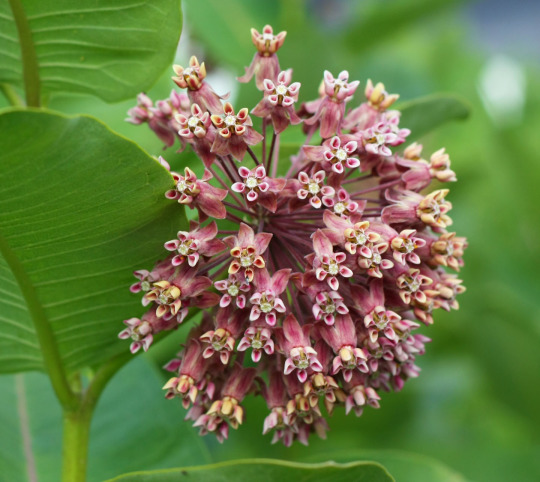
Common milkweed (Asclepias syriaca) is honestly just a classic. I love the light pink of the flowers, and those leaves are huge! I've heard they spread like wildfire, but with clusters of blooms like this? How can you even be too mad about that?

Showy milkweed (Asclepias speciosa). Honestly I'm not going to pretend I was always crazy about this species, but the more I see it pop up on iNaturalist, the more I find myself growing fond of it. These flowers look like crazy fireworks, and honestly, kinda have to stan.
"Oh, Ani, you have so many lovely favorites! Do you have any least favorite--" Tropical milkweed, hands down. I appreciate it's value as more of a 'babys first milkweed' plant but I'm tired of seeing it everywhere, especially knowing it's a bit invasive in my area?
Anyways, these are some of my favorite milkweed species! What are some of yours?
#milkweed#pollinator gardening#asclepias#asclepias humistrata#asclepias incarnata#asclepias syriaca#asclepias variegata#asclepias cordifolia#asclepias purparescens#asclepias speciosa#swamp milkweed#sandhill milkweed#pinewoods milkweed#redring milkweed#red ring milkweed#heartleaf milkweed#heart leaf milkweed#purple milkweed#common milkweed#showy milkweed#gardening#flowers#pink flowers#purple flowers#white flowers#ani rambles#out of queue#pollinator garden
207 notes
·
View notes
Note
hey I just now saw your tags on a post you reblogged of mine about native plants and I think you could totally start growing your own plants as long as you can find someone/somewhere to buy seeds from, I believe in you and your native plant dreams!!
Honestly homie I appreciate it!!
I think the main holdups for me are A: I’m consistently Average at best when it comes to growing seeds and B: I never know when to pot up
Also apparently a lot of native plants in my area don’t like being transplanted which would make growing them for the sole purpose of being transplanted. Tricky.
I would also need the money to buy the seeds because hoo doggy are native plant seeds kinda pricy 👀 but. Maybe I can do a little goofing off next year if I still don’t have an anim job? If all else fails itll be fun
#out of queue#ani rambles#answered asks#snekdood#gardening#genuinely like 10 sandhill milkweed seeds were like 12 bucks last year and I ended up transplanting them WAYYY late and idk if they’llmakei#but also like. idk. growing native plants and selling them on facebook marketplace or some shit doesn’t seem all too bad to start.#honestly the real DREAM would be selling seeds with illustrated seed packs that are my own prints#but I’m not THAT good at drawing plants#i am rambling again but like. 👀👀👀 maybe I’ll clown around and do it
16 notes
·
View notes
Text
so since I've basically seen all the seasons at my house now I've got a decent understanding of the micro-climate of my yard, and i need to document it somewhere so here goes:
front yard gets scorched. straight up. it doesn't really let up until 2-3 pm so i need full sun drought tolerant plants in the front area. (i dug some swales to redirect runoff from the foundation of the house, so its a little more moist than it was when we first moved in) this can be slightly mitigated by planting a couple dwarf trees in the very front area of the yard but that'll only help a little. i got a hardy hibiscus 'dark mystery' (Hibiscus Moscheutos, native perennial) that i plant to take cuttings of next year that has been loving the heat. This area i also plan to plant a bunch of milkweed (current varieties I'm planning to get are sandhill milkweed [asclepias Humistrata] green milkweed [Asclepias Viridis] Purple milkweed [Asclepias Purpurascens]) I'm also planning to get some native ornamental grasses to place around the entire property (including the front yard) some other plants i planning to plant are cardinal flower (Lobelia Cardinalis), liatris (liatris Spicata), Gaillardia (Gaillardia Pulchella), prairie sage (artemisia Ludoviciana), mountain mint (pycnanthemum muticum). more to be decided after i put this wave in. (definitely want some bee balm)
right side of the yard (by the house) is dark, cool, wooded, and wet. the rhododendron i put in was doing great until my brother in law took a lawnmower to it. :( but at least i can replace it. this is also where i have my feijoas (he also ran over them but they bounced back). probably will just add some rhododendrons & hydrangeas. i need to look up some more native shade plants for this area.
left side of the yard (by the house) gets even more sun than the front yard. i want to get a green house eventually (i have to replace all the windows in my house so I'll repurpose those for it) so this is probably the best place to do it.
backyard is large, part is dry and sunny, and towards the back is wooded. this is where i plan to put the fruit & nut trees i want. i need to thin out some of the less mature trees because they're extremely dense at the moment. (got a battery-powered chainsaw. i would have just borrowed my stepdads tools but hes convinced i would break them if i used them. :/ but at least now my father-in-law can borrow mine if he needs it) in the center of the backyard is where i have 2 12x4 gardens beds, and in the future i plan to add 2 more. this is where i have a lot of passionflower maypop plants, i transplanted some to the fenceline but i want an archway trellis as well. (i have watched probably over a hundred gulf fritillary caterpillars turn into butterflies, they're everywhere) the right side of the yard is where i plan to put the taller fruit & nut trees, (wont block sunlight) but i also want to get some dwarf fruit trees to place around as well. also this summer i saw lightning bugs in the backyard (!!!!!!!) so i plan to put in some grasses around an area that's like 12x12 ft across that dips down a few feet. (this area literally looks like a dried up small pond) i looked up how to use clay to create a natural lining for a pond, so this area will be good for lightning bugs, frogs, toads, salamanders, etc. this is in the lowest part of the yard, so its an optimal place for it.
this is just some basic plans for the future- i got a lot of seeds online so its not too break-the-bank expensive, and i get a lot of bushes and trees from etsy which can be great for saving money, despite the slight increased risk for mislabeled plants. i save money with this so i can get some nicer varieties of fruit trees that i really want (fuji apples, hosui pears, bing & rainier cherry trees).
my father-in-law really enjoys canning and preserving so I'm growing all the trees so i can give him some fruit to preserve (he lives in a very low-laying area, and a lot of it is swamp so he doesn't have as much room for fruit trees, his blackberry jam is amazing) also a guy my partner works with is into gardening as well (dudes he gave us so many peppers literally pounds of them) so i want to be able to return the favor with fruit. :) my mom and stepdad also have some fruit trees but I'm hoping to grow some that they don't have so we can trade.
ultimately i just want to grow as much food as possible and give it away to everyone who wants it, while also hosting the ultimate butterfly rest stop.
if you read this and enjoyed it, I'm glad! I'll post about these projects as i do them (which will be slowly) so i hope maybe this will inspire some of you :)
21 notes
·
View notes
Text



Florida Milkweed (Asclepias feayi) ✨🧚🏼♂️
One of only two milkweed species endemic to Florida! Found in sandhills and scrubby flatwoods of central to south Florida.
(a pair of weevils seem to be enjoying their time on this flower in the last pic)
Old Miakka Preserve, Sarasota, FL
July 2024
8 notes
·
View notes
Note
Happy sleepover saturday!!!!
I went to a plant sale!! They didn’t have sandhill milkweed like I was hoping for but I still somehow managed to obtain 42 dollars of plants on sheer impulse. I’m gonna drop them off (and my dad lol) and then go to a craft circle!!
I bestow Good Plant Sale Luck onto the homies. May you be more fruitful than I in your plant sale ventures.
~SolarpunkAni
Yay a plant sale!! That does sound fun! Good luck at craft circle!
And thank you for tye gift!!!
8 notes
·
View notes
Text

FLP CHAPBOOK OF THE DAY: Hard Feelings by Elizabeth R. McCarthy
On SALE now! Pre-order Price Guarantee: https://www.finishinglinepress.com/product/hard-feelings-by-elizabeth-r-mccarthy/
Elizabeth McCarthy lives in northern Vermont with her husband. She self-published her first poetry chapbook The Old House in 2020, and her second chapbook, Winter Vole was published by Finishing Line Press in 2022. Elizabeth’s poems appear in several magazines and literary reviews such as; The Washington Post, The Main Street Rag, Silver Birch Press, Blue Heron Review and many others. Elizabeth is a member of the Poetry Society of Vermont and an online member of The Lockdown Poets of Aberdeen, Scotland. #poetry #Vermont #nature
PRAISE FOR Hard Feelings by Elizabeth R. McCarthy
Hard Feelings, Elizabeth McCarthy’s second poetry collection, is filled with close observations of birds and other wildlife found in the Vermont countryside. Through metaphor and simile, form and imagination, the poet transforms these observations into the language of poetry. In the title poem, the last wild apples of the season are likened to grudges that linger and ferment, becoming “sour little/hearts that/rot in place.” In “Scuttled Memories,” an extended maritime metaphor evokes the sense of time passing when we leave our grief and regrets “stuck in the wooden hull/of memory.” Yet these are ultimately celebratory poems, full of the joy of discovery, like the old milkweed seeds that “burst open/the pod door — escaping/to whorl and dance/in the autumn sun.”
–Angela Patten, author of The Oriole & the Ovenbird, In Praise of Usefulness and other books.
In Elizabeth McCarthy’s beautiful, new collection, Hard Feelings, we enter a world of sandhill cranes, field crickets, spring peepers, odd cats, and cleansing rain. Present and thankful for ordinary moments, McCarthy shares her deep connection to nature and the whispered wisdom she receives. She speaks to us of her preferred world, “where understanding / is the sunrise.” Reverently hanging items of laundry in the summer sun, McCarthy writes about, “pinning them in silent prayer,” and we experience the day through her appreciative eyes. These are poems that offer solace, even when processing grief. Above all else, these are poems of hope, “for those who / believe in destiny / delivered in the night / of each new month.”
—Cristina M. R. Norcross, Founding Editor of Blue Heron Review; author of The Sound of a Collective Pulse and other titles
Please share/please repost #flpauthor #preorder #AwesomeCoverArt #poetry #chapbook #read #poems
#poetry#flp authors#preorder#flp#poets on tumblr#american poets#chapbook#chapbooks#finishing line press#small press
2 notes
·
View notes
Text
Today at Buffalo Creek Wildlife Preserve
After a long day of counting plants for my masters class project, and my partner doing ecological restoration work, both outdoors, both very sweaty, we decided to kick back and relax after dinner by identifying as many plants at a wildlife preserve as we could.
Before that, here is a list of the animals we saw while looking at the plants:
-Canada Geese
-Mallard ducks
-Swallow (tree?)
-Sparrow (spp. unsure)
-Redwing blackbirds
-Goldfinches
-Snowy egrets
-Great Blue heron
-Sandhill cranes
-Ladybugs* (ladybug larva?)
-Japanese beetle*
-Stinkbug (spp.?)
-Milkweed bug :)
-Monarch butterfly
-Muskrat
-Deer
-Bunnies!
-Little mouse/vole guy
Here is a list of plants (I'll start with the plants I added to iNat and then the other ones from memory); we did not attempt to identify most grasses/sedges/trees, this is mostly prairie plants and is not a complete list of plants in the region. I will include a little "?" for plants that we couldn't 100% determine or were only recommended through iNaturalist, and an asterisk for plants that are not native.
-false sunflower
-wild bergamot
-sawtooth sunflower
-purple prairie clover
-butterfly milkweed
-stiff-leaved goldenrod
-white campion*
-prairie crab apple (?)
-common milkweed
-common yarrow
-hackberry
-cottonwood
-queen anne's lace*
-oxeye daisy
-annual fleabane*
-prairie dock
-wild white indigo
-illinois bundleflower
-red clover*
-virginia mountain mint
-american senna
-rough cocklebur (*?)
-joe-pye weeds
-orange day-lily*
-ironweed
-oak (various)
-white sweetclover*
-yellow sweetclover*
-compass plant
-gray-headed coneflower/yellow coneflower
-purple coneflower
-cut-leaved teasel*
-canada thistle*
-bull thistle*
-birdsfoot trefoil*
-crown vetch*
-reed canary*
-big bluestem
-chicory*
-burdock*
-curly dock*
-cattails (may or may not be native*)
-vervain
-cup plant
-ragweed
-cut-leaved coneflower
-giant ragweed
-dogwood
-dogsbane
-tall goldenrod
-grass-leaved goldenrod
-virginia strawberry
-elm (?)
-prairie rosinweed
-orchard grass (?)*
-timothy grass (?)*
-switchgrass
-redtop
It was nice and late in the afternoon, cloudy, and there was rain forecasted but it didn't come until we were leaving (and even then it was barely drizzling). Overall we saw a lot of plants and animals! :)
3 notes
·
View notes
Text

Moon Milkweed and Sandhill Crane - Amy Rice , 2021.
American , b. 1950s -
Enamel, acrylic , ink and cut paper , 24 x 36 in.
208 notes
·
View notes
Text
redring milkweed
clasping milkweed
fewflower milkweed
sandhill milkweed
1 note
·
View note
Text
Sandhill Milkweed.

submitted by /u/deepbeastbeneath [link] [comments]
Sandhill Milkweed. published first on https://yeuhoavn.tumblr.com/
0 notes
Text
*cracks knuckles* Hey everyone!
Lately I've been trying to find information about Sandhill Milkweed, a type of milkweed native to quite a few states in the Southeast region. It's ended up being trickier than I would like, since not a lot of people seem to talk about it or even acknowledge it's existence. Well, it's time to acknowledge it's existence!
Sandhill Milkweed (Asclepias humistrata), also known as Pinewoods Milkweed, is a gorgeous specimen of the Asclepias family that's an excellent host for Monarch and Queen butterflies, thrives in dry soils, and might be the perfect addition to your garden! And I have compiled all of the information I've learned about it into this helpful Google Doc, so you can learn all about it!
This isn't a formal research paper or anything, this is just something I spent way too much time on a few days ago, but I'll be adding to it as people ask questions and I find answers! Feel free to leave comments, or links to more information!
Open your heart and let this funky milkweed in!
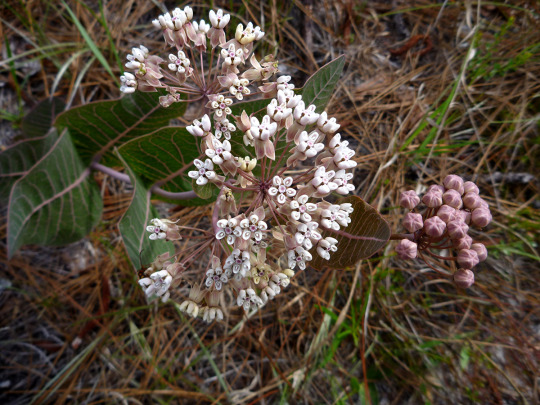
#asclepias humistrata#sandhill milkweed#pinewoods milkweed#milkweed#Asclepias#outdoor gardening#pollinator gardening#host plant#pollinator garden#monarch butterfly#gardening#garden#flowers#white flowers#ani rambles#out of queue
100 notes
·
View notes
Text
My Plans for Solarpunk Aesthetic Week 4
Solarpunk Aesthetic Week 4 begins TOMORROW!!!
I'm excited!!! But I'm also very busy!! (Retail during christmas time tends to do that unfortunately). So my goals are a bit more vague and sparse than usual, but hopefully I can do a few of them!
So my plans for now are
Crocheting! I have a cardigan I want to finish in time for a movie premiere, and after that I want to crochet an amigurimi as a Christmas gift for a friend! I also still owe my mom a bag--she keeps changing her mind on what pattern she wants, but if she decides soon I can start soon!
I ordered some sandhill milkweed seeds and I'm very excited to finally receive them and scatter them in the backyard!
I don't have a solarpunk short story ready to post this go-around, and I can't say for sure I'll have the burst of creative energy and inspiration needed to start and finish one--but we'll see! I have all week, after all!
I have some wildflower seeds from my garden I hope to offer as seed trades/giveaways in the Solarpunk Aesthetic Week server!
Maybe if I'm feeling the right vibes, I'll try to do some work on a children's book concept I wrote? If I'm extra feeling the vibes I might stream it.
Or I could stream Stardew Valley, that's also a hypothetical option
Maybe there's things I'll think of later! Maybe I'll spend an evening chilling in a library, or try and draw a solarpunk scene/building, or try going to a FNB meeting Sunday!
What are you guys hoping to do?
24 notes
·
View notes
Photo

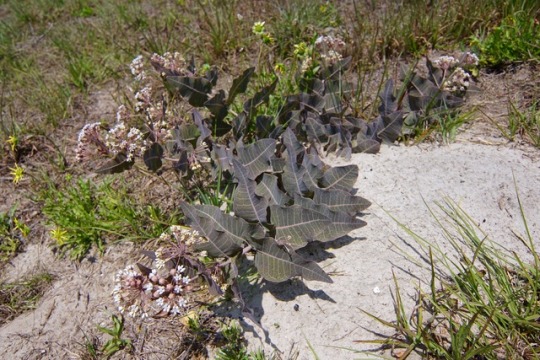
Sandhill Milkweed (Asclepias humistrata)
Cross Creek, FL
#Asclepias humistrata#milkweed#wildflowers#botany#nature#photography#Florida#north florida#cross creek
25 notes
·
View notes
Text
A Brief Glimpse at Sandhill Milkweed Roots
Aka someone or something knocked over my sandhill milkweed seedlings!!!!

May whoever or whatever did this feel a modicum of guilt!
Though it did honestly provide an interesting opportunity. Fortunately none of my milkweed seedlings fell out of their pots entirely, though the soil around them was loose enough that I could see the beginnings of their tap root. I decided, before I topped off with potting soil, to take a closer look at one.
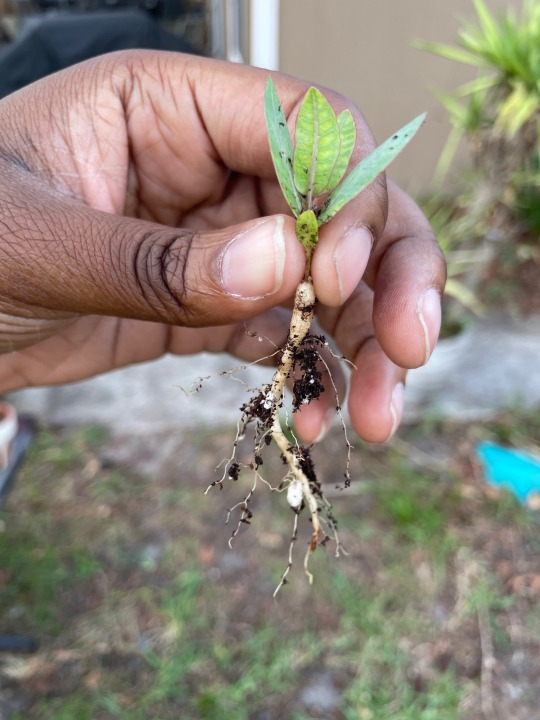

Look at how thick it is! Compared to its own stem, even! I knew they grew taproots, but dang! Sandhill milkweed is reported to grow tap roots as deep as 12 inches long, and it’s extremely clear that this growth habit starts early on.
Spent all this time trying to decide if they were growing too big for their pots or just grew slow, and I think I may have my answer…

Seems I should plan on transplanting sooner rather than later. They still seem so tiny though…
#milkweed#pinewoods milkweed#sandhill milkweed#asclepias humistrata#gardening#pollinator gardening#outdoor gardening#seedlings#out of queue#ani rambles#anis garden 2023#anis garden#milkweedposting#the milkweed queen has spoken
23 notes
·
View notes
Text
Top things I’d do differently if I were to grow sandhill milkweed/pinewoods milkweed/Asclepias humistrata again
1: bigger pot. Would probably start them in a taller pot like a reused solo cup or something.
2: one per pot. Maximum space for each plant no crowding.
3: transplant them earlier on. Or just start them directly in the ground. I now have EVIDENCE that they grow faster in the root department than they do in the stem height department and probably need to be in the ground by the time they’re 2 inches tall. Or even an inch and a half.
4: decide where I’m putting them early and keep it weeded until they’re ready. Part of the reason I delayed transplanting them was having no clue where the hell I wanted to put them and being too lazy to weed.
With that being said, things I think I did right.
1: My soil mix. I took potting soil and added perlite, mixed them together, then planted the seeds. From what I can tell it held enough water to be Reasonable while still staying dry enough for the milkweeds to be happy.
2: time I started them. Which was February 17th. Here in FL its just getting warm enough around then, and I think giving them an early start would be helpful in ensuring their longevity if I actually transplanted them in a timely manner.
Will almost definitely be buying more seeds and trying again.
8 notes
·
View notes
Text

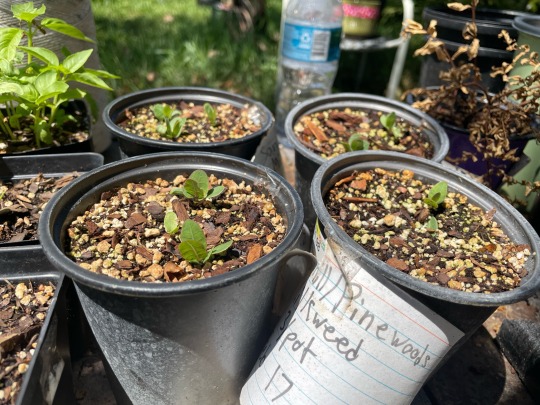
Can we just take a moment to appreciate how well my Sandhill Milkweed seedlings are doing? Look at them! I planted 12 seeds and 9 came up, thats pretty good!
I’m honestly wondering if I need to pot them up or just transplant them to the ground. Transplanting them this small makes me nervous but I don’t wanna give them transplant stress too many times either.
#or maybe they’re just growing slow because they’re Like That#pollinator gardening#outdoor gardening#gardening#milkweed#sandhill milkweed#pinewoods milkweed#asclepias humistrata#growing from seed#seedlings#asclepias#out of queue#ani rambles
3 notes
·
View notes